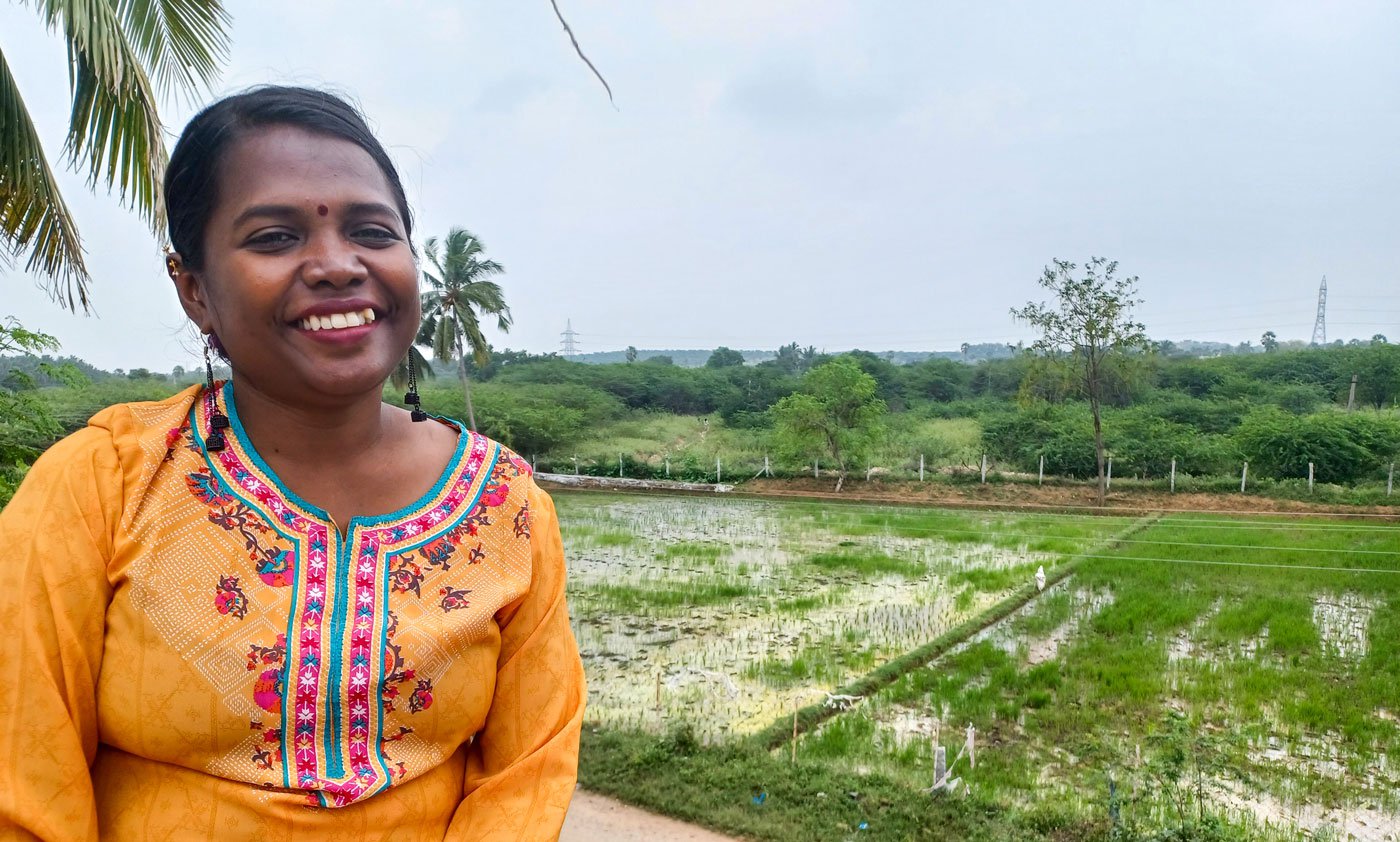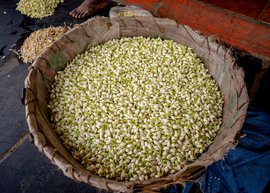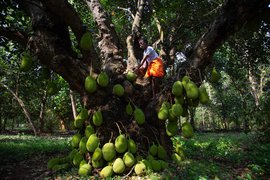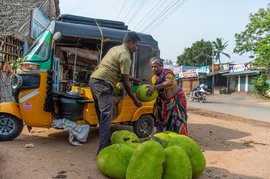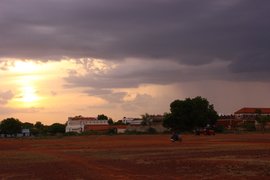Here we are in the scrub jungle, looking for the ‘Devil’s backbone.’ That’s what pirandai ( Cissus quadrangularis ) is called anyway. This square-stalked creeper that Rathy and I are searching for has many fine qualities. Typically, the tender new stem is picked, cleaned and preserved with red chilli powder, salt and sesame oil. Done properly, the pickle so created stays unspoilt for a year. And it tastes great with rice.
It's a warm January afternoon and our path to the jungle follows an ancient, dried-up creek. It has an evocative Tamil name: Ellaiathaamman Odai . Literally, the stream of the Goddess Without Boundaries. It’s a phrase that gives you goosebumps. And the trail – over rocks and sand, wide here, wet there – gives me some more.
Rathy tells me stories as we walk. Some are fictional and fun – on oranges and butterflies. Many are real and chilling – on the politics of food and caste clashes that spiked during the nineties, when she was in high school. “My family fled to Thoothukudi…”
Two decades later, Rathy is back in her village as a professional storyteller, library consultant and puppeteer. She talks slowly; she reads fast. “During the covid pandemic, in seven months, I read 22,000 big and small children’s books. At some point, my assistant begged me every day to stop reading. Otherwise, I began talking in dialogues.” And she laughs.
Her laughter is a gurgle, like the river she’s named after: Bhagirathy. She goes by the abbreviated Rathy, and lives about 3,000 kilometres south of the Himalayas where her namesake becomes the Ganges. Her village – Thenkalam, in Tamil Nadu’s Tirunelveli district – is surrounded by hills and scrub jungles. She knows them well, just as everybody in the village knows her.
“Why are you going to the jungle?” ask the women
labourers. “We’re foraging for
pirandai
,” Rathy replies. “Who is that
woman? Your friend?” demands the cowherd. "Yes, yes," Rathy grins, I
wave and we walk on...


Pirandai grows in the scrub forests of Tirunelveli, Tamil Nadu. Rathy finds a pirandai plant (right). The tender new stem is picked, cleaned and preserved with red chilli powder, salt and sesame oil and will remain unspoilt for a year
*****
Foraging for plants is a widespread, traditional practise across cultures and continents. It is tied in closely with the idea of Commons – the physical, natural and other resources available to all members of a society – where the wild produce of the region is consumed locally, seasonally and sustainably.
In Chasing Soppu , a book that celebrates urban foraging in the city of Bengaluru, the authors write that “collecting and utilising wild plants helps to preserve local ethno-ecological and ethno-botanical knowledge.” They note that – like in Thenkalam – it is women who typically gather wild plants. “They are vital knowledge holders and experts on the local wild plants around them. They know what parts of the plants are used for food, medicine, or cultural uses, and which is the best season to forage. They also have delicious recipes that have been passed down through the generations.”
An easy and appealing way to make seasonal produce last the year is to preserve them. Among the most popular methods are dry curing and wet pickling. In south India, particularly in Tamil Nadu, sesame ( gingelly ) oil is used instead of the more common agent vinegar.
“Sesame oil contains sesamin and sesamol. These
compounds are natural antioxidants and act as a preservative,” says Mary
Sandhya J, who has an M.Tech in Food Technology and her own brand of fish
pickle called ‘
Aazhi
’ (Ocean). Sandhya prefers cold pressed sesame oil
in her fish pickle, “mainly for the shelf-life extension, nutritional benefits,
taste and colour.”
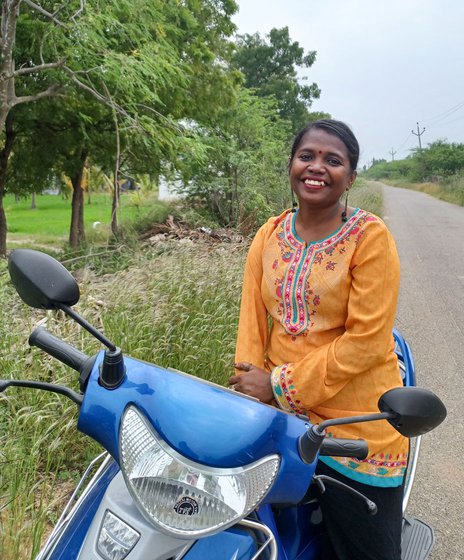
Foraging for plants is a widespread, traditional practise across cultures and continents, and wild produce is consumed locally, seasonally and sustainably. Each trip takes Rathy roughly four hours, and she walks up to 10 km to look for the plants. 'But after I bring them home,' she says laughing, 'I don’t know what happens to them'
Rathy’s family uses sesame oil in a number of preparations – pickle and gravies, made with vegetables and meats. But food hierarchies rankle her. “When an animal is killed in the village, the good parts used to go to the higher caste people. And offals [entrails and internal organs of the animal] came to us. We don’t have a history of meat dishes because we were never given the best cuts. We were only given the blood!” she says.
“Oppression, geography, local species of flora, fauna and animals, and caste hierarchy have deeply influenced the food culture of Dalit, Bahujan and Adivasi communities in ways that social scientists are still trying to map,” writes Vinay Kumar, in an essay titled 'Blood Fry and other Dalit recipes from my childhood' published in online magazine Goya.
Rathy’s mother Vadivammal has an “amazing method to clean blood, intestines and different parts,” she says. “Last Sunday, amma cooked blood. It is a delicacy in the city: blood sausage and blood pudding. Brain fry is supposed to be a super food. When I went to a city, I found the valorisation weird. Paying lots of money for what I would get for 20 rupees in the village.”
Her mother is also deeply knowledgeable about vegetation. “If you turn around, there are medicinal herbs and oils in those bottles,” Rathy tells me, in their living room. “My mother knows all the names and uses. Pirandai is supposed to have excellent digestive properties. Amma shows me what plant or herb she wants, I go to the forest, forage and clean it for her.”
These are seasonal produce and not available in the market. Each trip takes her roughly four hours and she walks up to 10 kilometres to look for the plants. “But after I bring them home,” Rathy laughs, “I don’t know what happens to them.”
*****


Rathy in the forest (left) plucking tamarind. The pods (right) used in foods across the country
The walk to the forest is enchanting. Much like a pop-up book for children, every turn has a surprise: butterflies here, birds there, and trees that throw big, beautiful shadows. Rathy points at berries which aren’t yet ripe for picking. “In a few days, they will be delicious,” she says. We rootle around for pirandai , but they’re all gone. “Someone’s picked them before us,” Rathy says. “But don’t worry, we’ll find some on our way back.”
As if to make up, she stops under a huge tamarind tree, bends a heavy branch and plucks a few pods. Snapping the brown shell between our thumb and forefingers, we devour the sweet-sour flesh. Her early reading memories include tamarinds. “I used to squirrel away in a corner, with a book, and chomp on green tamarind.” When she was a little older, she sat on a Kodukkapuli maram [monkey pod tree] in the backyard and read books. “ Amma chopped it down because I was climbing it when I was 14 or 15!” And she bursts out laughing.
It’s high noon and the sun beats down on our heads. It’s unusually fierce and withering for January. “Just a little further,” Rathy says, “we’ll reach the puliyuthu , that’s the water source for the village.” There are tiny patches of water along the edges of the dried-up stream. Butterflies dance on the mud puddles. They open their wings (inside, an iridescent blue) and shut their wings (outside, an ordinary brown). When I think it can’t get more magical…it does.
Puliyuthu
, the pond, is next to an ancient temple for the village goddess. Right
across, Rathy points out, a new one for Lord Ganesha has come up. We sit under
a huge banyan tree and eat oranges. Everything around us is soft – the afternoon
light deep in the forest; the sweet scent of citrus; the orange and black
fishes. And softly, Rathy tells me a story. ‘This one is called Pith, Pip and Peel,’ she begins. I listen, rapt.


Rathy tells me stories as we sit under a big banyan tree near the temple (right)
Rathy always loved stories. Her earliest memory is her father Samudram, who was a bank manager, getting her Mickey Mouse comics. “I remember very well: he got my brother Ganga a video game, my sister Narmada a toy, and he got me a book!” Rathy picked up the habit of reading from her father. He had a huge collection of books. Plus, her primary school had an extensive library. “They did not gatekeep the books and even opened up the rare section for me – national geographic and encyclopaedias, which were usually locked up. All because I liked books!”
She loved them so much, she spent her childhood reading. “There was this book translated from the Russian, which I thought we lost. I didn’t remember the title, only the images and story. Last year, I found it on Amazon. It’s about sea lions and sailing. Do you want to hear it?” And she narrates the story, her voice rising and falling, much like the waves and sea she describes.
Her childhood too was choppy, much like the sea. She recalls the violence around her, when she was in high school. “Stabbing. Buses being burnt. We constantly heard about it. In the village, we had a culture, they would screen a movie during festivals and functions. That was a prime source of violence. There would be a stabbing. When I was in Class 8, the violence was at its peak. Have you seen the movie Karnan ? Our lives were like that.” Karnan is a fictionalised account of the 1995 caste-riots in Kodiyankulam and stars actor Dhanush in the lead. ‘The story revolves around Karnan, a fearless and compassionate young man from a marginalized Dalit community who becomes the symbol of resistance against oppression.’ ‘The upper-caste villagers enjoy privilege and power, while the Dalits face discrimination.’
Until the late nineties when caste violence peaked, Rathy’s father used to live in a different city, where he worked. And she and her siblings stayed in the village with their mother. But for Classes 9, 10, 11 and 12 she moved to a different school each year.
Her life and experiences influenced her career
choices. “Look, I was a reader, in Tirunelveli, 30 years ago. There was nobody
to curate books for me. I picked up Shakespeare in primary school. Do you know
one of my favourite books is [George Eliot’s]
Mill On the Floss
? It is
about colourism and classism. It has a female with a dark skin as the lead. It
is prescribed in undergraduate courses. But since someone had donated it to
school, I read it in Class 4 and related to the lead character. I was also
hurt by her story…”


Rathy shows one of her favourite books (left) and puppets (right)
Several years later, when Rathy rediscovered children’s books, it set the course for her career. “I had no idea you had books for children. I had no idea there were books like Where the Wild Things Are and Ferdinand . They had been around for 80 or 90 years and kids in cities had read them. It made me think – what if I had access to these books when I was young? My journey would have been different. I’m not saying better, but different.”
Then again, reading is still seen as something that is taking away from academic work. “It’s seen as entertainment,” she shakes her head, “not skill building. Parents too only buy academic and activity books, they don’t see how kids can learn while having fun reading storybooks. Plus, there is a huge rural-urban gap. The kids from the villages are at least two to three scales (in reading levels) behind their counterparts in cities.”
And this is why Rathy likes working with rural kids. She has been conducting Lit-fests and book-fests for six years now, besides curating village libraries. Very often, she says, you find qualified librarians who maintain a great catalogue, but won’t always know what’s inside the book. “If they can’t recommend what you can read, it doesn’t make sense!”
Rathy lowers her voice conspiratorially. “One time a librarian asked me
“why are you letting children inside the library ma’am?” You should have seen
my reaction!” And her incredulous laughter fills the afternoon.
*****
We find the pirandai while walking back home. They’re tough and twisted over plants and shrubs. Rathy shows me the light green shoots we should pluck. The creeper breaks with a snap. She gathers it in her hand, a small tidy stack of pirandai, ‘Devil’s backbone’, the name making us laugh again.


Foraging and harvesting pirandai (Cissus quadrangularis), the creeper twisted over plants and shrubs
The plant will grow fresh shoots after a rain, Rathy promises. “We never pick the dark green parts. That’s like removing the breeding fish, isn’t it? How can you have small fry then?”
The walk back to the village is blistering. The sun is harsh, the palm trees and scrub jungle are brown and dry. The earth shimmers in the heat. A flock of migratory birds – black ibis – take flight as we walk closer. They soar gracefully, tucking their feet, spreading their wings. We reach the village square, where Dr. Ambedkar stands tall, with the Constitution in his hands. “I think it was only after the violence that his statue was protected with an iron mesh.”
Rathy’s house is a few minutes from the statue. Back in the living room, she tells me she finds stories cathartic. “There are a lot of emotions I play on the stage as a storyteller that I would not bring out otherwise. Even very simple emotions like frustration and exhaustion, you tend to cover it up and hustle along. But these are emotions I reveal on stage.”
The audience was not watching Rathy, she points out, but the character she was playing. Even grief finds an outlet on stage. “I have a beautiful fake cry that makes people run towards the room, saying they heard someone wail.” I ask if she can perform the wail for me, but Rathy laughs. “Not here, certainly not here, at least three relatives will come running asking what happened…”
It’s time for me to leave, and Rathy packs a generous batch of
pirandai
pickle.
It glistens with oil, it’s studded with garlic. And it smells like heaven, and reminds
me of the long walk on a warm day, to forage for green shoots and stories…


Cleaning and cutting up the shoots for making pirandai pickle


Cooking with garlic (left) and the final dish: pirandai pickle (right); recipe below
Rathy’s mother Vadivammal’s recipe for pirandai pickle:
Clean the pirandai and chop it fine. Wash well and drain well in a colander. There must be no water. Take a pan and add enough sesame oil for the pirandai . When hot, splutter mustard seeds, and add methi seeds and garlic pods if you like. Saute well until it becomes a rich copper colour. Pre-soak a ball of tamarind in water and squeeze for pulp – tamarind cuts the irritation that pirandai can cause. (Sometimes even when washing and cleaning it, the plant can make your hands itch.)
Add the tamarind water, followed by salt, turmeric powder, red chilli powder and asafoetida. Keep stirring, until the pirandai cooks well, and the whole mixture comes together, and the sesame oil floats on top. Let the pickle cool, and bottle it. It should keep for a year.
This research study is funded by Azim Premji University as part of its Research Funding Programme 2020.
